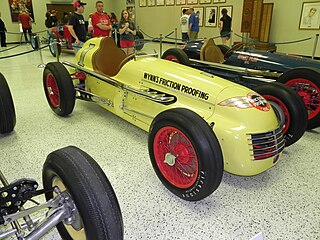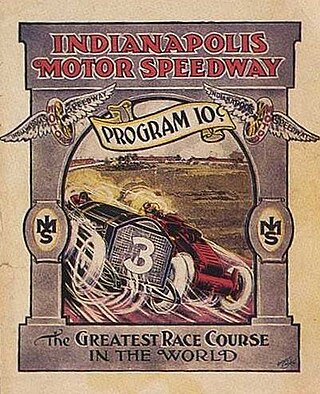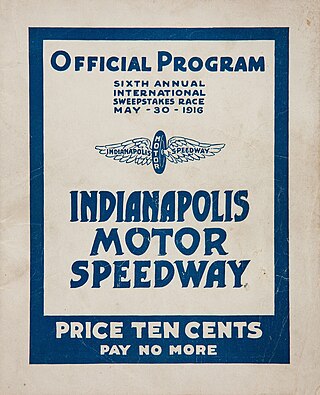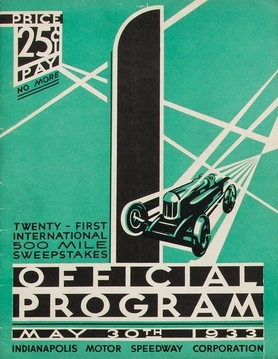
Fred Levon Agabashian was an American racer of midget cars and Indy cars.

The 34th International 500-Mile Sweepstakes was held at the Indianapolis Motor Speedway on Tuesday, May 30, 1950. The event was sanctioned by the AAA and served as the premier event on the calendar of the 1950 AAA National Championship Trail. For the first time, the race was included as a points-paying event towards the FIA-sanctioned World Drivers' Championship. The race was originally scheduled for 200 laps, but was stopped after 138 laps due to rain.

The 35th International 500-Mile Sweepstakes was held at the Indianapolis Motor Speedway on Wednesday, May 30, 1951. The event was part of the 1951 AAA National Championship Trail, and was also race 2 of 8 in the 1951 World Championship of Drivers. For the second year in a row, no European Formula One-based teams entered the race.

The 36th International 500-Mile Sweepstakes was a motor race held at the Indianapolis Motor Speedway on Friday, May 30, 1952. It was the opening race of the 1952 AAA National Championship Trail and was also race 2 of 8 in the 1952 World Championship of Drivers.

The 37th International 500-Mile Sweepstakes was held at the Indianapolis Motor Speedway on Saturday, May 30, 1953. The event was part of the 1953 AAA National Championship, and was race 2 of 9 in the 1953 World Championship of Drivers. Bill Vukovich, after falling just short a year before, dominated the race, leading 195 of the 200 laps. Vukovich won the first of two consecutive "500" victories, finishing more than three minutes ahead of second place Art Cross.

The 43rd International 500-Mile Sweepstakes was held at the Indianapolis Motor Speedway on Saturday, May 30, 1959. The event was part of the 1959 USAC National Championship Trail and was also race 2 of 9 in the 1959 World Championship of Drivers.

The 44th International 500-Mile Sweepstakes was held at the Indianapolis Motor Speedway in Speedway, Indiana on Monday, May 30, 1960. The event was race 2 of 12 of the 1960 USAC National Championship Trail and was also race 3 of 10 in the 1960 World Championship of Drivers. It would be the final time World Championship points would be awarded at the Indy 500.

Raffaele "Ralph" DePalma was an American racing driver who won the 1915 Indianapolis 500. His entry at the International Motorsports Hall of Fame estimates that he won about 2,000 races. DePalma won the 1908, 1909, 1910, and 1911 American AAA national dirt track championships and is credited with winning 25 American Championship car races. He won the Canadian national championship in 1929. DePalma estimated that he had earned $1.5 million by 1934 after racing for 27 years. He is inducted in numerous halls of fame. He competed on boards and dirt road courses and ovals.
Clark Thomas "Shorty" Templeman was an American racecar driver.

The Vanderbilt Cup was the first major trophy in American auto racing.

Donald C. Davidson was the historian of the Indianapolis Motor Speedway from 1998 to 2020, the only person to hold such a position on a full-time basis for any motorsports facility in the world. Davidson started his career as a statistician, publicist, and historian at USAC. His radio program, The Talk of Gasoline Alley, is broadcast annually throughout the "Month of May" on WFNI in Indianapolis, and he is part of the IMS Radio Network.

The 1911 International 500-Mile Sweepstakes Race was held at the Indianapolis Motor Speedway on Tuesday, May 30, 1911. It was the inaugural running of the Indianapolis 500, which is the most prestigious automobile race in the world. Ray Harroun, an engineer with the Marmon Motor Car Company, came out of retirement to drive, and won the inaugural event before re-retiring for good in the winner's circle.

The 46th International 500-Mile Sweepstakes was held at the Indianapolis Motor Speedway in Speedway, Indiana on Wednesday, May 30, 1962.

The 29th International 500-Mile Sweepstakes Race was held at the Indianapolis Motor Speedway on Friday, May 30, 1941. The start of the race was delayed due to a fire that swept through the garage area on race morning. No persons were injured, but one car in the field was destroyed. The race rolled off with only 31 cars, and ran to its scheduled distance. This would be the final "500" prior to the United States involvement in World War II along with the final race under with Eddie Rickenbacker as president of the speedway. He kept the track locked during the war before selling the track in November 1945 to Tony Hulman. The race returned a year later.
The 1942 Indianapolis 500 was scheduled for Saturday May 30, 1942, at the Indianapolis Motor Speedway. It was to be the 30th annual running of the famous automobile race. The race was canceled due to the United States involvement in World War II. In total, the Indianapolis 500 was not held from 1942 to 1945.

The 6th International 300-Mile Sweepstakes Race was the sixth running of the Indianapolis 500. It was held at the Indianapolis Motor Speedway on Tuesday, May 30, 1916. The management scheduled the race for 120 laps, 300 miles (480 km), the only Indianapolis 500 scheduled for less than 500 miles (800 km).

The 21st International 500-Mile Sweepstakes Race was held at the Indianapolis Motor Speedway on Tuesday, May 30, 1933. Louis Meyer defeated Wilbur Shaw by a time of 401.89 seconds. The average speed of the race was 104.162 miles per hour (167.632 km/h) while Bill Cummings achieved the pole position with a speed of 118.521 miles per hour (190.741 km/h). The race was part of the 1933 AAA Championship Car season.
Ronald Barth Duman, was an American racing driver who competed in the USAC Championship Car series and the Indianapolis 500. Duman was an accomplished driver in sprints and midgets, and won the prestigious Little 500 at Anderson Speedway in 1959 and 1960.
The 1911 Grand Prix season consisted of Grand Prix races in the United States and Europe. It was a significant year as European racing gradually came out of the doldrums. A Grand Prix was held in France again. The first Indianapolis 500 was held at Indianapolis Motor Speedway, joining the American Grand Prize as a leading race.

A riding mechanic was a mechanic that rode along with a race car during races, and who was tasked with maintaining, monitoring, and repairing the car during the race. The various duties included manually pumping oil and fuel, checking tire wear, observing gauges, and even massaging the driver's hands. They also communicated with the pits and spotted from inside the car. If the car ran out of fuel, or otherwise broke down, the riding mechanic was usually responsible for running back to the pits to fetch fuel or the necessary spare parts.

















